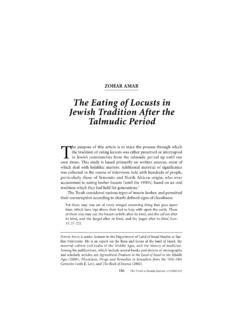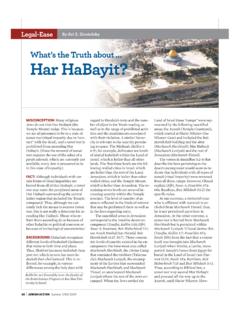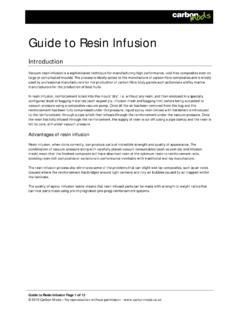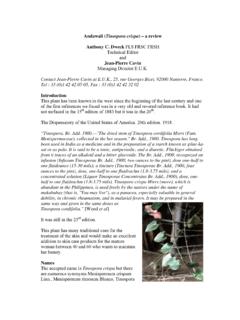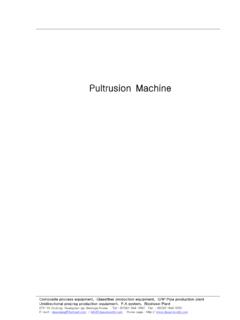Transcription of Medicinal properties of Commiphora gileadensis
1 African Journal of Pharmacy and Pharmacology Vol. 4(8), pp. 516-520, August 2010 Available online ISSN 1996-0816 2010 Academic Journals Full Length Research Paper Medicinal properties of Commiphora gileadensis David Iluz1,2,3,4*, Miri Hoffman1, Nechama Gilboa-Garber1 and Zohar Amar3 1 The Mina and Everard Goodman Faculty of Life Sciences, Bar-Ilan University, Ramat-Gan 52900 Israel. 2 Department of Environmental Science and Agriculture, Beit Berl Academic College, Doar Beit Berl 44905, Israel. 3 Talpiot College, Holon 58500, Israel. 4 Department of Land of Israel Studies and Archaeology, Bar-Ilan University, Ramat-Gan 52900, Israel.
2 Accepted 4 August, 2010 Commiphora gileadensis is a plant that was cultivated in ancient times in the land of Israel, particularly in the oases of the Dead Sea Basin Ein Gedi and Jericho. The plant, also known as balsam, was renowned for the expensive perfume that was produced from it, as well as for exceptional Medicinal properties that were attributed to its sap, wood, bark, and seeds. This article presents the historical sources describing these health-related properties and preliminary laboratory studies demonstrating the pharmacological effects of balsam sap.
3 Investigations of the antimicrobial activity of C. gileadensis showed the plant sap inhibitory effect against Bacillus cereus and the blocking of Pseudomonas aeruginosa lectins. These results corroborate the historical sources crediting the usefulness of balsam sap as an antiseptic agent. Key words: Commiphora gileadensis , balsam, resin, perfume, antimicrobial effects. INTRODUCTION Commiphora gileadensis (syn. Commiphora opobalsamum) is a tree in the Burseraceae family. There are those who identify this plant with the "balm" or "balsam" mentioned in translations of the Bible (Genesis 37:25; 43:11; Jeremiah 46:11, 8:22).
4 The balm of Judea was described in the Hellenistic and Roman-Byzantine periods as the world s most well-known and expensive perfume. It was recognized by all of the ancient writers Jewish, as well as Greek and Roman (Feliks, 1995; Stern, 1974-1984) and its existence and use were also reported in the archeological literature (Amar, 2002; Hepper and Taylor, 2004). The perfume was widely known in the Mediterranean Basin because balsam was cultivated exclusively in the land of Israel or, more precisely, in the oases of the Dead Sea Basin, Ein Gedi and Jericho.
5 It was recognized in ancient times, along with myrrh and frankincense, as a perfume and incense plant that grows in areas with very specific *Corresponding author. Email: Tel: 972(3)5318283. Fax: 972(3)7304058. ecological conditions (Groom, 1981). In the Middle Ages, balsam cultivation shifted to Egypt for approximately one thousand years (Milwright, 2001, 2003), but its importance has declined over the last few centuries. Different proposals have been offered for the identity of balsam (L w, 1967; Moldenke and Moldenke, 1952). However, from as early as the sixteenth century until modern times, researchers (Alpini, 1718; Feliks, 1995; Hepper, 1992; Linnaeus, 1764) have agreed with confidence that balsam is Commiphora gileadensis1 (=C.)
6 Opobalsamum), which grows wild today in the dry stony hills around the Red Sea, and especially within the borders of Saudi Arabia, Yemen, Oman, and Eritrea (Miller and Morris, 1988; Wood, 1997). We briefly survey ancient and more recent accounts of the Medicinal uses of balsam, and report on the bacterio- logical and biochemical tests that we carried out on the 1 In English it is called by several names: balsam of Mecca, balm of Gilead. It is possible that the name balsam also includes the species Commiphora kataf, but we will not deal with that here.
7 Plant s sap confirm, in principle, the historic records. EARLY ACCOUNTS ON BALSAM The Medicinal uses of balsam are mentioned frequently in the classical sources probably an offshoot of its fame as a widely used perfume component. It was claimed to have been used for the treatment of almost all human diseases. Diodorus (1961) and Tacitus (1956) described balsam in general terms as a Medicinal factor and mentioned its importance to physicians (Diodorus of Sicily, 1961; Tacitus, 1956). Galen (131-200 CE) listed it among the world s finest drugs.
8 The balsam of Judea (Apobalsami Iudaicae) is also mentioned in Mulomedicina Chironis (Mule-therapy by Chiron), an anthology of medicines for veterinary use compiled in the second half of the fourth century (Stern, 1974-1984). All parts of the balsam plant were used in medicine, and Pliny (1989) noted that even the bark was sold for making drugs. Its sap (also called a resin) was particularly known for its ability to cure headaches, early-stage cataract, and blurred vision (Largus, 1887; Strabo, 1961). Oil containing balsam sap was considered of prime value in preparing Medicinal ointments and compresses, and its other parts (bark, wood, and seeds) were used in various drugs (Celsus, 1961; Largus, 1887).
9 Preparations containing the sap were considered to be effective in the treatment of hearing disorders, paralysis, stroke, and in mending fractures. Small doses of resin were recommended, because an excess could aggravate an illness (Pliny, 1989). Balsam was also used as a diuretic drug, as a cure for respiratory diseases and coughing, and as an anti-toxin acting as a snake-bite antidote (Gunther, 1959; Largus, 1887). In addition, it was also used in the field of traditional gynecology for the treatment of cervical infections and for delaying men-struation (Gunther, 1959).
10 Applying balsam sap to the opening of the cervix before sexual relations was believed to act as a contraceptive (Temkin, 1991). The Rabbinic literature mentions a tonic known as aluntis, which was composed of old wine mixed with clear water and balsam. It was drunk in the bathhouse after bathing as a cooling beverage or to anoint and strengthen the body (Talmud Bavli, 1997). In his treatise, the physician Assaph ha-Rofe (ca. 8-9th centuries) referred to diverse Medicinal uses of balsam. However, most of his information was derived from the classical medical literature (primarily Disocorides), and he ended his extensive survey with the statement, Give to drink [of this tonic] for all illnesses and it will cure them, and it will eliminate also every ache that may be in the stomach and bowels, and in most cases it will bring cures (Muntner, 1969).
